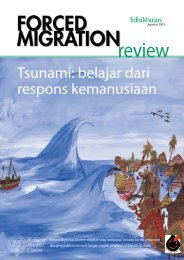FMR 42 full issue pdf - Forced Migration Review
FMR 42 full issue pdf - Forced Migration Review
FMR 42 full issue pdf - Forced Migration Review
Create successful ePaper yourself
Turn your PDF publications into a flip-book with our unique Google optimized e-Paper software.
<strong>FMR</strong> <strong>42</strong><br />
Sexual orientation and gender identity and the protection of forced migrants 21<br />
common asylum procedure and a uniform<br />
status valid throughout the EU. Despite<br />
the developments on the definitional scope<br />
brought by the 2004 Qualification Directive,<br />
a study in 2011 on the treatment of asylum<br />
claims related to sexual orientation and<br />
gender identity found that there were still<br />
considerable differences in the way in which<br />
EU Member States treat LGBTI applications. 4<br />
EU Member States adopted an amended<br />
version of the Qualification Directive in<br />
2011 and this version marked progress<br />
by making explicit reference to gender<br />
identity. The second part of the relevant<br />
text of Article 10(1)(d) of the Directive now<br />
reads as follows: “Gender related aspects,<br />
including gender identity, shall be given due<br />
consideration for the purposes of determining<br />
membership of a particular social group or<br />
identifying a characteristic of such a group.”<br />
Not only does the Directive now explicitly<br />
include gender identity but it also entails<br />
an obligation for decision-makers to give<br />
consideration to gender-related aspects,<br />
including gender identity – reflected by<br />
the use of “shall” instead of ”might”. Even<br />
with this strengthened wording, however,<br />
and the inclusion of gender identity, it<br />
does not unambiguously include intersex<br />
individuals, although the Directive does<br />
recognise in Article 9(2) that gender-specific<br />
acts and child-specific acts fall within<br />
the concept of persecution and<br />
both of these references<br />
can be relevant in cases of<br />
persecution of intersex people. 5<br />
Disappointingly, the 2011 Directive<br />
retained the word ‘and’ between<br />
the phrases referring to immutable<br />
characteristics and social perception;<br />
this could lead national decisionmakers<br />
to require both these elements<br />
to be fulfilled if applicants are to be<br />
considered members of a particular<br />
social group, a practice which leaves<br />
certain applicants unprotected. Finally,<br />
both versions of the Directive put<br />
consideration of sexual orientation and<br />
gender identity under the membership of<br />
particular social group ground. However,<br />
as UNHCR stressed in its recent Guidelines<br />
on claims based on sexual orientation or<br />
gender identity, “other grounds may though<br />
also be relevant depending on the political,<br />
religious and cultural context of the claim;<br />
for example advocacy by LGBTI activists<br />
may be seen as going against prevailing<br />
political or religious views and/or practices”. 6<br />
Evangelia (Lilian) Tsourdi is a PhD candidate at<br />
the Université Libre de Bruxelles and Research<br />
Assistant at the Université Catholique de Louvain<br />
liliantsourdi@gmail.com<br />
1. UNHCR, Guidelines On International Protection: “Membership of a<br />
particular social group” within the context of Article 1A(2) of the 1951<br />
Convention and/or its 1967 Protocol relating to the Status of Refugees,<br />
2002, para 11. www.unhcr.org/3d58de2da.html<br />
2. UNHCR, Guidelines On International Protection: Claims to Refugee<br />
Status based on Sexual Orientation and/or Gender Identity within the<br />
context of Article 1A(2) of the 1951 Convention and/or its 1967 Protocol<br />
relating to the Status of Refugees, 2012, para <strong>42</strong>.<br />
www.unhcr.org/509136ca9.html<br />
3. Odysseus Academic Network, Directive 2004/83: Qualification<br />
Directive Synthesis Report, Done for DG JLS of the European<br />
Commission, 2007, pp52-53.<br />
4. See Spijkerboer, T & Jansen, S, Fleeing Homophobia: Asylum Claims<br />
Related to Sexual Orientation and Gender Identity in Europe, 2011,<br />
http://tinyurl.com/Fleeing-Homophobia-report See also article by<br />
Śledzińska-Simon & Śmiszek pp16-18.<br />
5. ILGA-Europe, Guidelines on the transposition of the Asylum<br />
Qualification Directive: protecting LGBTI asylum seekers, 2012 , p9<br />
http://tinyurl.com/ILGA-Tsourdi-2012<br />
6. www.unhcr.org/509136ca9.html See also article by Turk pp5-8.<br />
ASYLUM CLAIMS RELATED<br />
TO SEXUAL ORIENTATION AND<br />
GENDER IDENTITY IN EUROPE<br />
SABINE JANSEN AND THOMAS SPIJKERBOER<br />
GUIDELINES<br />
on the transposition<br />
of the Asylum<br />
Qualification Directive:<br />
protecting LGBTI<br />
asylum seekers<br />
Evangelia (Lilian) Tsourdi




